初中牛津上海版英语教案
(完整版)沪教牛津版初中英语七年级上册全套教学案

7A UNIT 1 Making friendsⅠ重点单词:world n. 世界country n. 国家Japan n.日本Germany n. 德国German adj.德国的n.德国人grammar n.语法 blog n. 博客sound n. 声音everyone n.人人(谓语动词要用单数)hobby n.爱好(复数hobbies)age n. 年龄elder adj. 年长的dream n. 梦想complete v. 完成us pron.我们 yourself pron.你自己friendly adj. 友爱的engineer n. 工程师 flat n.公寓mountain n. 山Ⅱ重点短语:1.colse to 接近 = near 反义词:far (away)from 远离2.go to school 去上学3.be good at 擅长 =do well in 反义词:be bad /poor at=do badly in不擅长4.make friends with 与……交朋友 make friends 交朋友5.all over 遍及6.I’d like to=I would like to 愿意Ⅲ重点句型:1.what does···mean?2.welcome to3.I like···because···4.My dream is to be··.5.How old is/are ····?6.What does ····do?Ⅴ详细讲解:1.Read a G erman girl’s blog.(Page1)(1)German :① adj.德国的(德国人的,德语的)This is a German car.② n.德国人,是可数名词。
牛津上海版英语七年级上册Unit10教学设计

(三)学生小组讨论
1.教学活动:学生分组,根据教师提供的家庭场景,运用所学的词汇和句型进行讨论。
2.设计意图:培养学生的合作精神,提高学生的口语表达能力,巩固所学知识。
3.教学步骤:
a.教师给出讨论话题,如:“Introduce your family members and their daily activities.”
2.掌握本单元的主要句型:学生能够运用本单元所学的句型,如:“This is my family.”、“I have a brother.”等,进行自我介绍和家庭成员的介绍。
3.能够运用一般现在时描述家庭成员的日常活动和特征:学生能够运用一般现在时,如:“My father works in a hospital.”、“My mother is a teacher.”等,描述家庭成员的职业和特征。
b.学生分组讨论,每人负责介绍一位家庭成员。
c.各组展示讨论成果,教师给予评价和指导。
(四)课堂练习
1.教学活动:教师设计不同形式的练习,如填空、选择、改错等,帮助学生巩固所学知识。
2.设计意图:检验学生对本节课知识的掌握程度,及时发现并解决学生存在的问题。
3.教学步骤:
a.教师呈现练习题,学生独立完成。
5.学生合作能力:七年级学生团队合作意识逐渐增强,善于与同学交流、分享。在教学过程中,教师应充分利用这一点,组织丰富的合作学习活动,培养学生的团队协作能力。
三、教学重难点和教学设想
(一)教学重难点
1.重点:本章节的重点在于学生能够熟练掌握一般现在时,运用所学的词汇和句型介绍家庭成员和日常活动。
难点:一般现在时的正确运用,尤其是动词的变化形式,以及如何将其运用到实际情景中进行自然的交流。
)沪教牛津版初中英语八年级下册全套教学案

)沪教牛津版初中英语八年级下册全套教学案一、教学目标:1. 熟练掌握该课程的重点词汇和短语。
2. 能听懂和口语交流本单元所学知识。
3. 提高阅读能力,学习阅读技巧。
4. 培养动手实践能力,积极参与课堂活动。
二、教学重点与难点:1. 了解词汇的意思和用法以及本单元的重点短语。
2. 熟悉阅读技巧,提高阅读能力。
3. 培养动手实践能力,使学生更好的理解和掌握本单元知识。
三、教学内容:1. 重点单词:weight, health, rarely, regularly, profit, competition, instruction, presentation, energy, relaxed, nervous, fitness, concentrate, coordinate2. 重点短语:lose weight, give instructions, take part in, be relaxed, be nervous, energy drinks, figure out3. 阅读技巧:skimming and scanning4. 课堂活动:口语交际练习、听力练习、阅读理解练习、实践活动。
四、教学方法:1. 情境教学法2. 演示教学法3. 互动式教学法五、教学过程:1. 导入通过放一段视频或图片,引起学生的兴趣和好奇心,用自己的话简要描述其中的人或事。
2. 自主学习要求学生阅读或朗读本单元的课文,听音频或看视频,注意课文中的重点词汇和短语。
学生在自主学习的过程中,可以采用自己的方式,如读或背单词、模仿或演绎对话,或通过画画或电脑录制等形式来加深印象。
3. 互动探究根据所学内容进行互动探究,学生可以通过组合或匹配单词和短语来练习。
也可以进行角色扮演,让学生在实际情境中运用所学语言。
4. 实践活动通过实践活动的方式,让学生更加深入的了解所学单词和短语的应用场景。
如制作海报、口头介绍健康饮食、设计健身计划、动手制作健身用品等等。
2024年初中牛津上海版英语教案
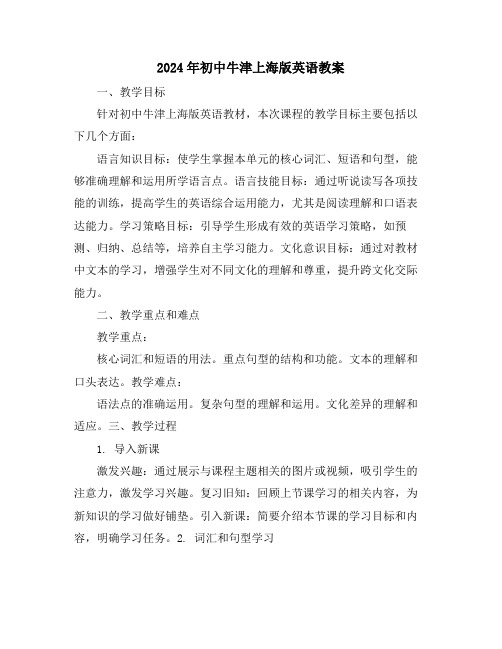
2024年初中牛津上海版英语教案一、教学目标针对初中牛津上海版英语教材,本次课程的教学目标主要包括以下几个方面:语言知识目标:使学生掌握本单元的核心词汇、短语和句型,能够准确理解和运用所学语言点。
语言技能目标:通过听说读写各项技能的训练,提高学生的英语综合运用能力,尤其是阅读理解和口语表达能力。
学习策略目标:引导学生形成有效的英语学习策略,如预测、归纳、总结等,培养自主学习能力。
文化意识目标:通过对教材中文本的学习,增强学生对不同文化的理解和尊重,提升跨文化交际能力。
二、教学重点和难点教学重点:核心词汇和短语的用法。
重点句型的结构和功能。
文本的理解和口头表达。
教学难点:语法点的准确运用。
复杂句型的理解和运用。
文化差异的理解和适应。
三、教学过程1. 导入新课激发兴趣:通过展示与课程主题相关的图片或视频,吸引学生的注意力,激发学习兴趣。
复习旧知:回顾上节课学习的相关内容,为新知识的学习做好铺垫。
引入新课:简要介绍本节课的学习目标和内容,明确学习任务。
2. 词汇和句型学习呈现新词汇:通过实物、图片或多媒体等方式呈现新词汇,帮助学生直观理解。
讲解词汇用法:详细解释新词汇的用法,包括词性、搭配等,并给出例句。
句型操练:通过替换、填空等方式,让学生操练重点句型,加深对句型的理解。
3. 文本理解和口头表达阅读文本:指导学生阅读教材文本,注意理解文本中的重点信息和语言点。
小组讨论:组织学生进行小组讨论,就文本内容展开讨论,培养口语表达能力。
汇报交流:每个小组选派代表汇报讨论成果,其他同学进行点评和补充。
4. 语法点讲解和练习呈现语法点:明确本节课的语法点,通过例句展示其用法。
讲解语法规则:详细解释语法点的构成和用法,帮助学生理解。
语法练习:设计多种形式的练习,如填空、选择、改写等,让学生充分练习。
5. 文化差异理解和适应对比文化:通过对比中英文化中的相似点和差异点,帮助学生理解文化差异。
讨论交流:组织学生就文化差异进行讨论交流,分享自己的见解和体验。
上海牛津 初中 教案
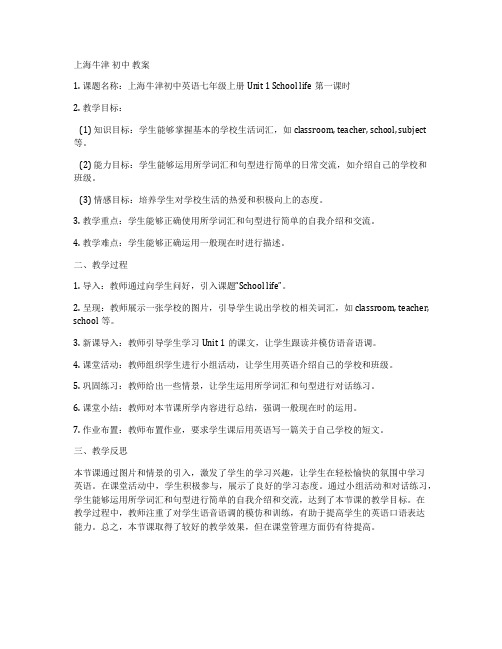
上海牛津初中教案1. 课题名称:上海牛津初中英语七年级上册Unit 1 School life第一课时2. 教学目标:(1) 知识目标:学生能够掌握基本的学校生活词汇,如classroom, teacher, school, subject 等。
(2) 能力目标:学生能够运用所学词汇和句型进行简单的日常交流,如介绍自己的学校和班级。
(3) 情感目标:培养学生对学校生活的热爱和积极向上的态度。
3. 教学重点:学生能够正确使用所学词汇和句型进行简单的自我介绍和交流。
4. 教学难点:学生能够正确运用一般现在时进行描述。
二、教学过程1. 导入:教师通过向学生问好,引入课题“School life”。
2. 呈现:教师展示一张学校的图片,引导学生说出学校的相关词汇,如classroom, teacher, school等。
3. 新课导入:教师引导学生学习Unit 1的课文,让学生跟读并模仿语音语调。
4. 课堂活动:教师组织学生进行小组活动,让学生用英语介绍自己的学校和班级。
5. 巩固练习:教师给出一些情景,让学生运用所学词汇和句型进行对话练习。
6. 课堂小结:教师对本节课所学内容进行总结,强调一般现在时的运用。
7. 作业布置:教师布置作业,要求学生课后用英语写一篇关于自己学校的短文。
三、教学反思本节课通过图片和情景的引入,激发了学生的学习兴趣,让学生在轻松愉快的氛围中学习英语。
在课堂活动中,学生积极参与,展示了良好的学习态度。
通过小组活动和对话练习,学生能够运用所学词汇和句型进行简单的自我介绍和交流,达到了本节课的教学目标。
在教学过程中,教师注重了对学生语音语调的模仿和训练,有助于提高学生的英语口语表达能力。
总之,本节课取得了较好的教学效果,但在课堂管理方面仍有待提高。
牛津上海版英语七年级上册全册教案
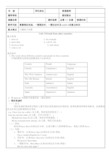
Unit 3 Friends from other countries重点短语1. most of2. for example3. more than4. c all sb. sth.[来源:学+科+网]5. far away from6. read about7. write to sb.[来源:学科网ZXXK]语法知识1. The words about different countries and people in these countries.不同的国家名称和这些国家的人们的叫法。
Country People Languag eCanada[来源:学&科&网]Canadian(s) EnglishThe USA/ America America n(s) EnglishThe UK/ Britain British EnglishIndia Indian(s) IndianAustralia Australian(s) EnglishJapan[来源:学&科&网]Japanese(s) Japanese[来源:学,科,网Z,X,X,K]2. 用there be句型表示客观存在(就近原则)3.现在完成时(一)含义现在完成时用来表示现在之前已发生或完成的动作或状态,但其结果却和现在有联系, 也就是说, 动发生在过去但它的影响现在还存在。
e.g. I have lost my wallet. (含义是:现在我没有钱花了。
)Jane has laid the table.(含义是:已可以吃饭了。
)Michael has been ill.(含义是:现在仍然很虚弱。
)He has returned from abroad. (含义是:现在已在此地)(二)结构助动词have /has+动词过去分词,主语为第三人称单数用has,其他人称用have 。
(三)句型1、肯定句:主语+have /has+动词过去分词+其他。
上海初中牛津教案
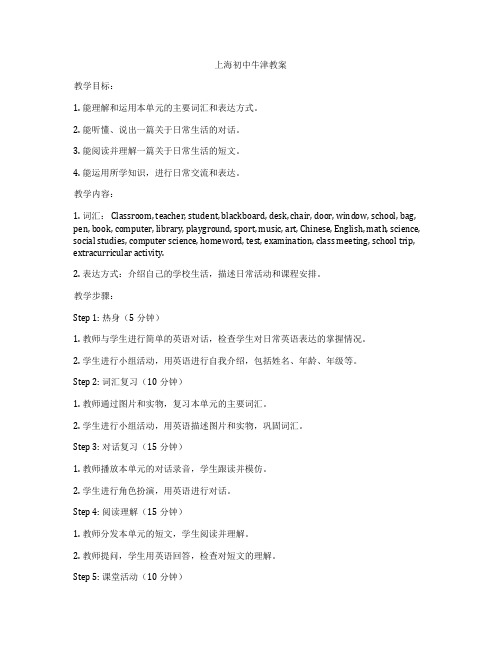
上海初中牛津教案教学目标:1. 能理解和运用本单元的主要词汇和表达方式。
2. 能听懂、说出一篇关于日常生活的对话。
3. 能阅读并理解一篇关于日常生活的短文。
4. 能运用所学知识,进行日常交流和表达。
教学内容:1. 词汇: Classroom, teacher, student, blackboard, desk, chair, door, window, school, bag, pen, book, computer, library, playground, sport, music, art, Chinese, English, math, science, social studies, computer science, homeword, test, examination, class meeting, school trip, extracurricular activity.2. 表达方式:介绍自己的学校生活,描述日常活动和课程安排。
教学步骤:Step 1: 热身(5分钟)1. 教师与学生进行简单的英语对话,检查学生对日常英语表达的掌握情况。
2. 学生进行小组活动,用英语进行自我介绍,包括姓名、年龄、年级等。
Step 2: 词汇复习(10分钟)1. 教师通过图片和实物,复习本单元的主要词汇。
2. 学生进行小组活动,用英语描述图片和实物,巩固词汇。
Step 3: 对话复习(15分钟)1. 教师播放本单元的对话录音,学生跟读并模仿。
2. 学生进行角色扮演,用英语进行对话。
Step 4: 阅读理解(15分钟)1. 教师分发本单元的短文,学生阅读并理解。
2. 教师提问,学生用英语回答,检查对短文的理解。
Step 5: 课堂活动(10分钟)1. 教师组织学生进行小组活动,用英语讨论学校生活。
2. 学生展示自己的小组活动成果,用英语进行表达。
Step 6: 总结与作业(5分钟)1. 教师对本节课的内容进行总结,强调重点和难点。
Unit10教案牛津上海版英语七年级上学期

Lesson PlanUnit 10 Period 1 (p 75-76)Course: Oxford EnglishClass: B2Time: 40 minutesObjectives: 1. Learn new words and phrases: free, watch some cartoons, etc.2. Review and practice the ways of asking and answering telephones.3. Discuss activities of the party4. Show your acceptance and declines properly.Materials: computer, ppt, Oxford English book.1.Warm up(1) Do dictation.(2) (ppt 2) Discuss: what about your birthday party? What do you usually do at the party?2.While-teaching(1)(ppt 3) Teach 2 activities. We may sing karaoke and play chess on my birthday party.(2)(ppt 4-5) Now, let’s get to know more about the activities on a birthday party. Listen to thetext once and then answer true / false questions.(3)(ppt 6-8) Read and dialogue between Kitty and Peter once. Then summarize the ways ofaccepting an invitation.(4)(ppt 9-12) Listen to the dialogue, complete the true/ false questions. Read the dialogue onceand then get to know the ways of declining an invitation.3.Post-teaching(1) (ppt 13-14) Pair work: Use the phone to invite a classmate to your friend’s birthday party. Youcan add some other interesting activities. One acceptance and one rejection.(2) (ppt 15-16) Read the information on the birthday invitation card, and then complete the blanks.(2) Homework:a.Recite all the new words and text. Copy new words.b. (ppt 17) Write back to Patrick and let him know you can/ cannot come to his party. Andgive your reasons.Lesson PlanUnit 10 Period 2 (p 78)Course: Oxford EnglishClass: B2Time: 40 minutesObjectives: 1. Review new words and phrases: would rather do, soya milk, etc.2.Learn and review the ways of expressing likes and dislikes.3.Buy things in a supermarket with shall we ....Materials: computer, ppt, Oxford English book.1.Warm up(1)Do dictation (new words and sentences learned in the previous lesson).(2)(ppt 2) Listen to the dialogue and then complete the shopping list. And also learn 2 new words.Spring roll and soya milk.2.While-teaching(1) (ppt 3-5) Read the dialogues together once and then discuss the ways of giving suggestions.(2)(ppt 6-7) Listen to Eddie and Mary talking about a birthday party programme and completethe shopping list. Then, listen again and complete the birthday party programme.3.Post-teaching(1) (ppt 8) Group work: discuss the things you need for your birthday party and them makedialogues.(2) Homework:a. Recite all the new words and key sentences (including the ones in Notes).Unit 10 Period 3 (p 77)Course: Oxford EnglishClass: B2Time: 40 minutesObjectives: 1. Learn new words and phrases: beat 2 eggs, stir the mixture, etc.2. Re-enforce sequence words: firstly, secondly, then, finally, etc.3. Get to know the ingredients and steps of making a chocolate cake.Materials: computer, ppt, Oxford English book.1. Warm up(1) Do dictation (new words and sentences learned in the previous lesson).(2) (ppt 2) Kitty going to make a cake for Peter. She is discussing with her mother. Whatingredients do they need to make a chocolate cake?2. While-teaching(1) (ppt 3) Learn some other ingredients needed: icing, powder.(2) (ppt 4-5) Listen to their dialogue and complete the shopping list.(3) (ppt 6) Listen to the dialogue again and then read aloud.(4) (ppt 7-8) Review and learn more movements for making cakes.(5) (ppt 9-12) Fill in the blanks with the help of pictures and key words above. Make clear eachstep and read the whole sequence together once.3. Post-teaching(1) (ppt 13) Group work: make our DIY cake, we need... (ingredients) and also list your steps.(2) (ppt 14) Pair work: Put the pictures in the right order and tell your classmates how you canmake a tasty hamburger.(3) Homework:a. Recite all the new words and key sentences (including the ones in Notes).b. Recite page 77.Unit 10 Period 4 (p 79-80)Course: Oxford EnglishClass: B2Time: 40 minutesObjectives: 1. Learn new words and phrases:batteries, balloons, candles, etc.2. Learn grammar: need something, need do to, don’t need to do.3. Get to know the importance of sound preparation.Materials: computer, ppt, Oxford English book.1. Warm up(1) Do dictation (new words and sentences learned in the previous lesson).(2) (ppt 2) Brain storm: besides food, at a birthday party, we also need ...2. While-teaching(1) (ppt 3) Replace the pictures with words just mentioned: At a birthday party, in order to do ...,we need ...(2) (ppt 4-5) Kitty is asking Mrs Li about the things she needs to buy for Ben’s birthday party.Click and star to listen to the dialogue, and according to the dialogue, get the correct things they need. Maybe you need to buy some candles and matches.(3) (ppt 6-7) Listen to the dialogue again and then read aloud.(4) (ppt 8) Pair work: according to them, What does Kitty need to buy for Ben’s birthday party?With the help of the shopping list and key sentences pattern, students make the dialogues themselves.(5) (ppt 9) Pair work: with the pictures, practice using need:S1: Do we need a / any... ? S2: Yes, we need ... because we’d like to... / No, we’re not going to..., so we don’t need...3. Post-teaching(1) (ppt 10) Group work: We are going to have a Christmas party in our class. Discuss with yourgroup members what you need to do or need to buy for the party by using “ need to.../ ..., so...”(2) (ppt 11-13) Pair work: During this winter holiday, a group of students from SJFH will go on astudy trip to Japan. To have a nice trip and enjoy themselves, what do they need or need to do?Before leaving, on the plane and after arriving.(3) (ppt 14-16) Complete the exercise on page 80, listen to the passage once, read aloud once andthen put Kitty’s photos in the correct order, complete the captions.(4) Homework:a. Recite all the new words and key sentences (including the ones in Notes).b. Writing: Did your class/school/family have a New Year party last December? Write ane-mail to your penfriend and tell him something about it. You should write more than 80 words.When and where did you have the party?What did you do to prepare for the party?What did you do at the party?What do you think of the party?。
沪教牛津初中英语教案

沪教牛津初中英语教案【篇一:2015-2016沪教牛津版初中英语八年级上册全套教学案【含答案】】2015-2016沪教牛津版初中英语八年级上册全套教学案content第一讲........................................................................................................ . (2)unit1 language points................................................................................................. .2第二讲........................................................................................................ . (9)grammar-不定代词 (9)第三讲........................................................................................................ (13)unit2 language points (13)第四讲........................................................................................................ (27)grammar-数词 (27)第五讲........................................................................................................ (35)unit3 language points (35)第六讲........................................................................................................ (46)grammar-形容词和副词 (46)第七讲........................................................................................................ (56)unit4 language points (56)第八讲........................................................................................................ (70)grammar-形容词副词同级比较 (70)第九讲........................................................................................................ (76)unit5 language points (76)第十讲........................................................................................................ (89)grammar-现在完成时 (89)第十一讲........................................................................................................ .. (97)unit6 language points.................................................................................................97 第十二讲........................................................................................................ ............108grammar-现在完成时补充.............................................................................108 第十三讲....................................................................................................................116 unit7 language points.. (1)16 第十四讲........................................................................................................ ............128grammar-if条件状语从句..............................................................................128 第十五讲........................................................................................................ ............133 unit8 language points.. (1)33 第十六讲........................................................................................................ ............138grammar-情态动词.........................................................................................138 优乐单元测........................................................................................................ .. (144)vocabulary......................................................................................... . (230)八年级上册英语教案资料第一讲unit1◆知识探究1. is my encyclopaedia , lo?1) useful: 有用的,有益的,有帮助的 a useful book2) use +ful= useful 名词+ful= 形容词3) 以-ful结尾的形容词的反义词多是相应的以-less结尾的形容词。
上海牛津英语9a教案
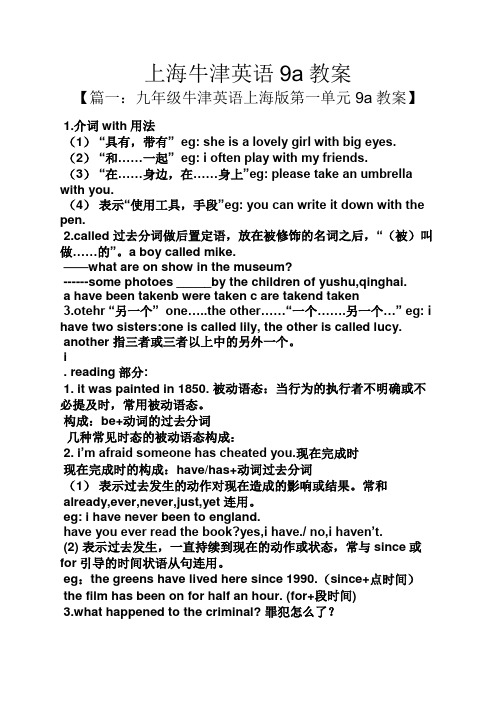
上海牛津英语9a教案【篇一:九年级牛津英语上海版第一单元9a教案】 1.介词with用法(1)“具有,带有” eg: she is a lovely girl with big eyes.(2)“和……一起” eg: i often play with my friends.(3)“在……身边,在……身上”eg: please take an umbrella with you.(4)表示“使用工具,手段”eg: you can write it down with the pen.2.called 过去分词做后置定语,放在被修饰的名词之后,“(被)叫做……的”。
a boy called mike.——what are on show in the museum?------some photoes _____by the children of yushu,qinghai.a have been takenb were takenc are takend taken3.otehr “另一个” one…..the other……“一个…….另一个…” eg: i have two sisters:one is called lily, the other is called lucy.another 指三者或三者以上中的另外一个。
i. reading部分:1. it was painted in 1850. 被动语态:当行为的执行者不明确或不必提及时,常用被动语态。
构成:be+动词的过去分词几种常见时态的被动语态构成:2. i’m afraid someone has cheated you.现在完成时现在完成时的构成:have/has+动词过去分词(1)表示过去发生的动作对现在造成的影响或结果。
常和already,ever,never,just,yet连用。
eg: i have never been to england.have you ever read the book?yes,i have./ no,i haven’t.(2) 表示过去发生,一直持续到现在的动作或状态,常与since或for引导的时间状语从句连用。
初中牛津上海版英语教案
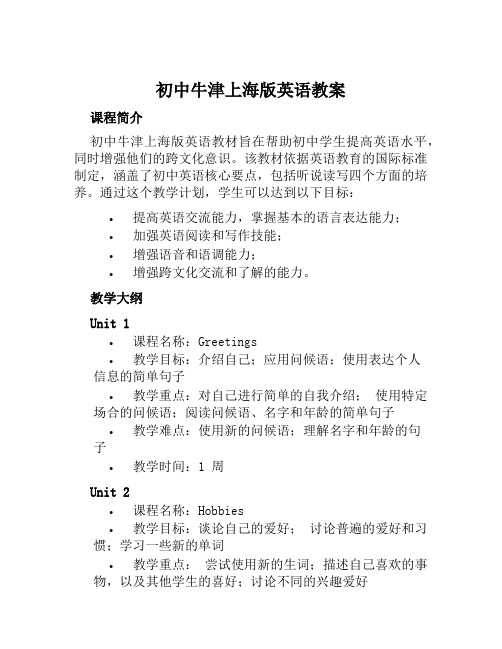
初中牛津上海版英语教案课程简介初中牛津上海版英语教材旨在帮助初中学生提高英语水平,同时增强他们的跨文化意识。
该教材依据英语教育的国际标准制定,涵盖了初中英语核心要点,包括听说读写四个方面的培养。
通过这个教学计划,学生可以达到以下目标:•提高英语交流能力,掌握基本的语言表达能力;•加强英语阅读和写作技能;•增强语音和语调能力;•增强跨文化交流和了解的能力。
教学大纲Unit 1•课程名称:Greetings•教学目标:介绍自己;应用问候语;使用表达个人信息的简单句子•教学重点:对自己进行简单的自我介绍;使用特定场合的问候语;阅读问候语、名字和年龄的简单句子•教学难点:使用新的问候语;理解名字和年龄的句子•教学时间:1 周Unit 2•课程名称:Hobbies•教学目标:谈论自己的爱好;讨论普遍的爱好和习惯;学习一些新的单词•教学重点:尝试使用新的生词;描述自己喜欢的事物,以及其他学生的喜好;讨论不同的兴趣爱好•教学难点:学会描述自己和别人的爱好;辨别并理解新单词;•教学时间:2 周Unit 3•课程名称:At school•教学目标:谈论日常学习和校园生活的事宜;使用英语日常用语;学会描述一天的安排•教学重点:学会使用英语表述日常生活会话,如用餐场合等;了解日常用语;学会描述日常学习和生活安排•教学难点:掌握英式英语与美式英语在表述上的区别;学会使用一些日常用语;•教学时间:3 周Unit 4•课程名称:Vacation•教学目标:谈论假期计划;了解不同的假期传统和活动;学会使用描述天气和季节的语言•教学重点:通过对话了解不同的假期活动和计划;学会描述天气和季节;学会使用关于假期的常用词汇•教学难点:掌握描述天气和季节的语言;学会使用一些与假期相关常用词汇•教学时间:2 周Unit 5•课程名称:Food and Drink•教学目标:了解并介绍中外饮食文化;可简要介绍某个菜肴的制作过程;学会叙述食物口感、外观及味道等相关词汇•教学重点:对中国和西方的饮食文化进行介绍;学会描述食物外观、味道和口感•教学难点:理解并使用一些中西方餐饮文化的词语;学会使用相关的口感、外观、味道等描述词汇•教学时间:3 周教学方法•学习课文基础知识;•开设小组讨论;•课后讲解课文重点;•模拟英语对话和口语练习;•组织语音和语调练习;•外出实地访问和学习。
沪教牛津版初一下册英语全册教案(教学设计)

沪教牛津版七年级下册初中英语全册教案(教学设计)Unit 1 People around us 教案课题:Unit 1 --- People around us (阅读课)课时:第 1 课时,共4课时课型:new words教学目标:1.To know the meaning of the new words and the students can use the words to make sentences.2.To train the students’ ability o f cooperation.教学重点: The pronunciation and the usages of the new words: cheerful , hard-working , patient, person, smart, forget, smell , strict, encourage, remain , support successful, remember.教学难点: The usages of the new words: forget , remember , patient , strict, remain , strict.教学准备: e some pictures and games and PPT .2.a recorder .教学步骤:Step 1 Warming up. Freely talk:who do you like best around you ?show some pictures of teacher,father ,mother,friend, on the PPT to talk about them.Step 2 New words.1.Read the new words after the teacher or the tape.2.Group work to remember the new words3.Help the students when they have trouble in reading the new wordsStep 3 Key words learning.1.Show the PPT of the meaning of the key words for them to finish Part A1.2. Let Ss make more sentences with the new words .Step 4 Have a competitioncheck the words and give them marks for the groupsstep5 ReadingBefore reading : 1.Ask Ss to look at the pictures and the titles of the three articles on page 3.2.Check their answers.While reading : 1.Read the article quickly, and then finish Part D1.2. Check their answers.Post reading: 1.Ask Ss to finish Part C1 and C2.2. Check their answers.Step 6 Reciting the article1.Play the tape for them to listen and repeat.2.Show PPT for them to retell the article.ExercisesTo consulate the usages of the new wordsstep 7 SummaryGive them a piece of paper to write the words.Step 8 Homework1.Dictation2.correct the mistakesStep9 The blackboard designUnit 1 People around us1. be cheerful快乐2.as well 也3.take care of 照顾4.tell jokes 讲笑话5.make sb laugh 使某人发笑6.be good at 擅长于…7.be strict in sth 对某事严格要求be strict with sb对某人严格要求课题:Unit 1 People around us (听说课)课时:第2课时,共 4 课时课型:Listening & Speaking教学目标:1.Learn how to use the new words or phrases to describe a person2. improve their listening and speaking skills教学重点: To catch the missing words when listening教学难点: Learn to take note quickly when listening教学准备: Group work. Self—study教学步骤:Step 1: Prepare for the listening and speakingReview some words and phrases which can be used to describe a person Step 2: Do the listening1.Play the listening materials , stop when necessary2.Check the answersStep3.SpeakingGive a sample dialogue to students and ask them to imitate itStep 4:Make notes about the listening.1.Tell them to find the key words.2.Write down the key words you get in the listening part.Step5 Speaking1.学习双元音/iə/、/eə/、/uə/1)Read after the teacher or the tape.2)Read by themselves.2.Listen to the tape and finish A1 then check their answers.3.Learn A2. Ask Ss to read these sentences. Pay attention to the letters in red.4.Speaking upWork in groups to discuss the people they like .S1: Who do you like?S2: I like …S1: What does/did he/she look like?…Step6:Sum upStep7HomeworkStep8 The blackboard designUnit 1 People around us1.描写人的外貌的词2. 双元音/iə/、/eə/、/uə/课题:Unit 1 People around us(语法及运用课)课时:第3时,共 4 课时课型:Grammar教学目标:1.to grasp the usage of the definite word the and the preposition with2. to raise the students’ ability to sum up some language rules教学重点: Know when should use the in front of a noun and when we should not use it and the usage of the with phrases to describe a person教学难点: When we should not use the in front of a noun.教学准备:PPT, Blackboard教学步骤:Step1:Free talkTalk about the noun with an, a and the .Step2: WritingBefore writing: Give Ss the title of the article to talk about.1.Who are you going to write about?2.Think about the following ideas.1)a family member2)a good friend3)a teacher or a great personWhile writing:1.Write a short article about this person.Show some PPT to help them to write the article.2.介绍一些描述人常用的词汇.3. Ask Ss to re ad “My dad”as an example.Step3:More practiceAsk Ss to re ad the article about Mother’s Day quickly.Then answer the questions.1.When is Mother’s Day?2.What do people like to do this day?3.What do the author advise people to do on this day?Step4 Study skills1.Learn line graphs and bar charts to show the change in numbers.2.Fill in the blanks.3.Check their answers.Step 4:Culture corner1.Introduce middle names for Ss.2.Write some famous people’s middle names.Step5:Sum up1.Go over the rules of theStep6: HomeworkStep7 The blackboard design1.冠词“a\an”的用法。
牛津上海版七年级上Unit3 Period1教案(英语教案)
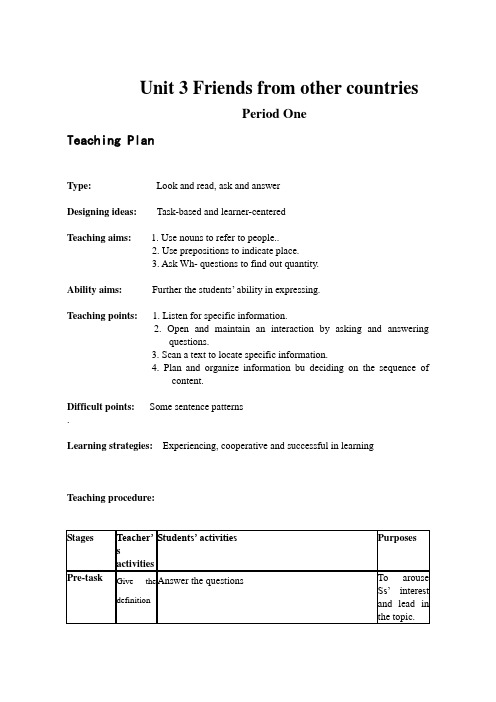
.
Learning strategies:Experiencing,cooperative and successful in learning
Teaching procedure:
Stages
Teacher’s activities
Look, learn and say.
Let Sswrite the two numbers in figures.
( To review “ hundred, thousand and million)
Say the following numbers
To help Ss think of the numbers.
Assignment
1.Learn the vocabularies by heart.
2.Do workbook.
2. Use prepositions to indicate place.
3. Ask Wh- questions to find out quantity.
Ability aims:Further the students’ ability in expressing.
Teaching points:1. Listen for specific information.
To help Ss get familiar with Garden City.
Do pair work.
Do pair work
S1: What do we call people from …?
S2: We call them….
To get Ss familiar with the sentence patterns.
沪教牛津版七年级上册初一英语全册教案(教学设计)

果
评
价
与
反
思
Period 2
课题
Unit 1 Making friends
课型
Reading
备课时间
1 period
教
材
分
析
教学目标
4.The students can get the main idea of the passage.
5.Their ability of reading and cooperation is trained .
Period 1
课题
Unit1 Making friends
课型
NEW WORDS
备课时间
1 Period
教
材
分
析
教学目标
1.Students can master how to pronounce the new words and master the meanings of the words .
Step three: while-reading.
Reading comprehension.
Step four: Discussion
2. fill in the blank and answer the question :what are your hobbies?
Talk with your friends about your hobbies , can choose the phrases given on the ppt
3. play the Mp3 of the text and let students follow the reading
4. show the questions on a sheet like : a. Where is Anna from ? b. what does she look like? c. How many people are there in her family? d. How does she go to school every day?
新沪教牛津版七年级上册英语 Unit 3 Period 4 教案
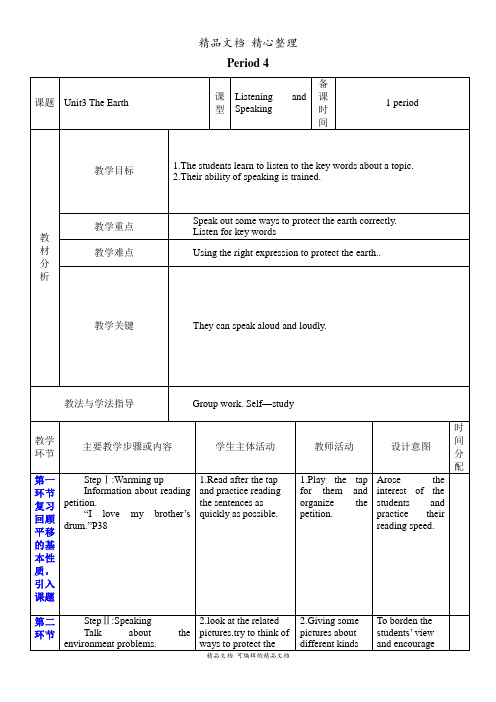
第五环节 课后作业
1.朗读课文P31
2.《综合练习册》P40
课
堂
教
学
流
程
Warming up→ Speaking→ Listening →Speaking
效
果
评
价
与
反
思
(partner work)
2.look at the related pictures.try to think of ways to protect theearth like:
we must..:
3.①Talk about the photos.
“What’s this?”“It’s a bowl.”“What’s inside it?”“Some rice.”
,lead them to provide ways to protect: what can we do ?
3.①Lead the students to describe the photes.
dirty unpleasant
②Play the tap for them.
4.Set an example to make a dialogue.
5.To help the students develop some ways of listening.
第四环节 课时小结
StepⅥ;Summerize
6.List the kinds of pollutions on the earth.
6.Limt the time for them to list.
②Listen to the tap ቤተ መጻሕፍቲ ባይዱnd fnish the exercise.
初中沪教牛津教案

初中沪教牛津教案教学目标:1. 能够听懂、会说、会读本单元的生词和重点句子。
2. 能够通过图片和文字描述自己喜欢的动物,并能够表达出它们的特点。
3. 能够运用本单元所学知识进行简单的日常交流。
教学内容:1. 生词:monkey, panda, tiger, elephant, giraffe, zebra, parrot, cat, dog, fish, bird2. 重点句子:- What's your favorite animal?- My favorite animal is...- It's got...- How cute!/How beautiful!/How funny!教学过程:Step 1: 热身(5分钟)1. 教师与学生进行简单的英语对话,询问学生喜欢的动物。
2. 学生自由讨论并分享自己喜欢的动物。
Step 2: 引入(10分钟)1. 教师展示本单元的生词卡片,引导学生说出单词。
2. 教师用PPT展示各种动物的图片,引导学生用英语描述这些动物。
Step 3: 新课内容(15分钟)1. 教师引导学生学习本单元的重点句子。
2. 学生跟读并模仿教师的发音。
3. 教师组织学生进行小组活动,让学生用本单元的句子和生词进行交流。
Step 4: 实践环节(10分钟)1. 教师给出一个动物的话题,让学生用本单元的知识进行描述。
2. 学生分组进行讨论,并选择一个代表进行汇报。
Step 5: 总结与作业(5分钟)1. 教师对本节课的内容进行总结。
2. 学生回家后,用本单元的知识写一篇关于自己喜欢的动物的短文。
教学评价:1. 教师通过课堂观察和学生的作业完成情况来评价学生的学习效果。
2. 在下一节课开始时,教师可以让学生分享自己写的短文,以此检验学生对所学知识的掌握程度。
以上就是针对初中沪教牛津版英语七年级下册《Unit 5 Our animal friends》的教案,希望能够对您的教学有所帮助。
初中牛津上海版英语教案
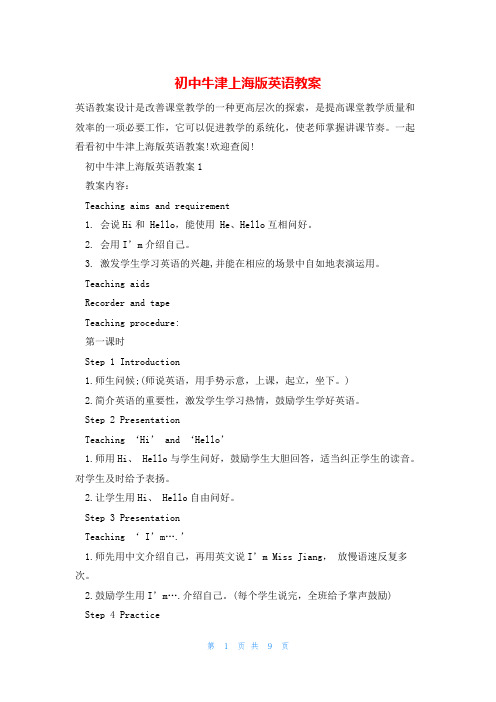
初中牛津上海版英语教案英语教案设计是改善课堂教学的一种更高层次的探索,是提高课堂教学质量和效率的一项必要工作,它可以促进教学的系统化,使老师掌握讲课节奏。
一起看看初中牛津上海版英语教案!欢迎查阅!初中牛津上海版英语教案1教案内容:Teaching aims and requirement1. 会说Hi和 Hello,能使用 He、Hello互相问好。
2. 会用I’m介绍自己。
3. 激发学生学习英语的兴趣,并能在相应的场景中自如地表演运用。
Teaching aidsRecorder and tapeTeaching procedure:第一课时Step 1 Introduction1.师生问候;(师说英语,用手势示意,上课,起立,坐下。
)2.简介英语的重要性,激发学生学习热情,鼓励学生学好英语。
Step 2 PresentationTeaching ‘Hi’ and ‘Hello’1.师用Hi、 Hello与学生问好,鼓励学生大胆回答,适当纠正学生的读音。
对学生及时给予表扬。
2.让学生用Hi、 Hello自由问好。
Step 3 PresentationTeaching ‘ I’m….’1.师先用中文介绍自己,再用英文说I’m Miss Jiang,放慢语速反复多次。
2.鼓励学生用I’m….介绍自己。
(每个学生说完,全班给予掌声鼓励)Step 4 Practice1.师用Hi/Hello, I’m Miss Jiang. 与学生问好,引导学生用 Hi/Hello, I’m …作答。
2.学生分组用Hi/Hel lo, I’m 互相自我介绍。
3.唱《找朋友》,让学生下位用“Hi/Hello, I’m”找朋友。
4.指名上台表演。
5. 引导学生展开想象,让他们在类似的生活场景中运用所学语言。
T: Hello ,I am Miss Jiang .S: Hello ,I am Mike .Step 5 Act用Hi/Hello,I’m…. Goodbye /Bye向全班同学介绍自己。
上海牛津初中教案
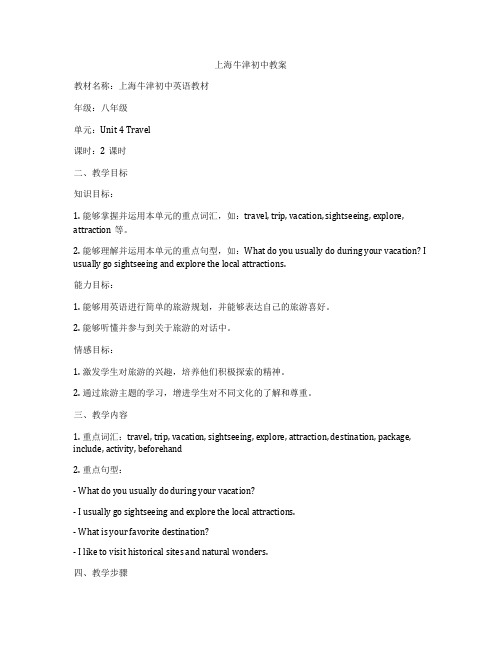
上海牛津初中教案教材名称:上海牛津初中英语教材年级:八年级单元:Unit 4 Travel课时:2课时二、教学目标知识目标:1. 能够掌握并运用本单元的重点词汇,如:travel, trip, vacation, sightseeing, explore, attraction等。
2. 能够理解并运用本单元的重点句型,如:What do you usually do during your vacation? I usually go sightseeing and explore the local attractions.能力目标:1. 能够用英语进行简单的旅游规划,并能够表达自己的旅游喜好。
2. 能够听懂并参与到关于旅游的对话中。
情感目标:1. 激发学生对旅游的兴趣,培养他们积极探索的精神。
2. 通过旅游主题的学习,增进学生对不同文化的了解和尊重。
三、教学内容1. 重点词汇:travel, trip, vacation, sightseeing, explore, attraction, destination, package, include, activity, beforehand2. 重点句型:- What do you usually do during your vacation?- I usually go sightseeing and explore the local attractions.- What is your favorite destination?- I like to visit historical sites and natural wonders.四、教学步骤第一课时:1. 导入:教师通过展示不同旅游目的地的图片,引导学生谈论他们最喜欢的旅游目的地。
2. 新课呈现:教师展示本课时的词汇和句型,引导学生进行认读和模仿。
3. 小组活动:学生分成小组,用所学的词汇和句型讨论他们的旅游计划。
- 1、下载文档前请自行甄别文档内容的完整性,平台不提供额外的编辑、内容补充、找答案等附加服务。
- 2、"仅部分预览"的文档,不可在线预览部分如存在完整性等问题,可反馈申请退款(可完整预览的文档不适用该条件!)。
- 3、如文档侵犯您的权益,请联系客服反馈,我们会尽快为您处理(人工客服工作时间:9:00-18:30)。
初中牛津上海版英语教案教案内容:Teaching aims and requirement1. 会说Hi和 Hello,能使用 He、Hello互相问好。
2. 会用I’m介绍自己。
3. 激发学生学习英语的兴趣,并能在相应的场景中自如地表演运用。
Teaching aidsRecorder and tapeTeaching procedure:第一课时Step 1 Introduction1.师生问候;(师说英语,用手势示意,上课,起立,坐下。
)2.简介英语的重要性,激发学生学习热情,鼓励学生学好英语。
Step 2 PresentationTeaching ‘Hi’ and ‘Hello’1.师用Hi、 Hello与学生问好,鼓励学生大胆回答,适当纠正学生的读音。
对学生及时给予表扬。
2.让学生用Hi、 Hello自由问好。
Step 3 PresentationTeaching ‘ I’m….’1.师先用中文介绍自己,再用英文说I’m Miss Jiang,放慢语速反复多次。
2.鼓励学生用I’m….介绍自己。
(每个学生说完,全班给予掌声鼓励)Step 4 Practice1.师用Hi/Hello, I’m Miss Jiang. 与学生问好,引导学生用 Hi/Hello,I’m …作答。
2.学生分组用Hi/Hello, I’m 互相自我介绍。
3.唱《找朋友》,让学生下位用“Hi/Hello, I’m”找朋友。
4.指名上台表演。
5. 引导学生展开想象,让他们在类似的生活场景中运用所学语言。
T: Hello ,I am Miss Jiang .S: Hello ,I am Mike .Step 5 Act用Hi/Hello,I’m…. Goodbye /Bye向全班同学介绍自己。
Step 7 Homework回家用所学的句型与父母问好、道别。
Some thoughts after the lesson: ☆教学调整☆初中牛津上海版英语教案2教案内容:1.能听得懂,会说单词Su Hai, Mike, Helen, Wang Bing .2.能正确地运用日常交际用语Hello, I am ,激发学生学习英语的兴趣,并能在相应的场景中自如地表演运用Step 1 Free talk师生之间互相问好,打招呼,复习句型Hello/Hi, I’m ….T: Hello/Hi, I’m MissJiang…. S: Hello/Hi, I’m ….Step 2 Presentation出示头饰,逐个介绍新朋友Su Hai, Wang Bing, Helen, Mike。
用中文讨论图画,他们来自哪儿?会说些什么?师戴头饰T: Hi, I’m Su Hai.S1: Hi, I’m S1.T: Goodbye, S1.S1: Goodbye, Su Hai.在交往中让学生认识四个新朋友。
Step 3Practice.1、听录音,指出书中人物。
2、再听录音,跟读课文。
3、分组操练,四组分别是Su Hai, Wang Bing, Helen, Mike,学生下位找朋友,最少找五个,巩固本课句型。
Step 4Act .1、指名学生戴上头饰,下位走动,向本组同学问候。
2、请一组学生到前面围成一圈,叫圈里两个学生的名字,这两个学生走到中间说:“Hello/Hi, I’m …”,然后握手,接着说“ Goodbye.”Step 5 Consolidation找人物,涂颜色,说出他们的姓名。
复习巩固所学的句型和人物。
Step 6 Homework.听录音,熟记书中人物姓名。
初中牛津上海版英语教案3教案内容:教学内容和要求:1.会读Learn to say 中的内容,并知道句子的意思。
2.学会说good morning ,good afternoon, good evening, ,准确知道它们的意思,并能够初步学会运用。
3.复习Unit 1 的内容,要求读说流利,应用自如。
4. 能正确演唱本单元的歌曲。
教学重点:1.让学生学会说morning, afternoon , evening ,并理解意思2.初步学会运用good morning, good afternoon ,good evening 说话。
教学难点:1. good morning,中字母d要失去爆破;good afternoon ,good evening 中两个单词连读。
教学准备:磁带,图片,实物(笔,文具盒,橡皮等)教学方法:跟读,领读,游戏第一课时教学过程:一.复习1.朗读unit 1中look and learn .齐读并指名读,要求注意语音语调2. 看图片说名字,分组或指名说二.教学look and learn .1.学生看图片,用中文说一说这是什么2. 激发兴趣,教说单词 morning afternoon evening教师在学生用中文回答时,用英文说出短句,让学生跟读,理解意思3.跟读磁带,反复练习4. 指名学生说,教师正音后齐读5. 带领学生做游戏,让学生观察 morning afternoon evening这三张图片,再认读。
三.教学Listen ,point and learn to say .1.看图说话,图上有什么,是什么时间,他们会说什么初中牛津上海版英语教案4教材简析:本单元的日常交际用语主要用于“询问爱好”。
Do you play …?Do youlike …? What do you play ?都是一般现在时的疑问句,在现阶段教师并不需要把有关一般现在时的语法知识传授给学生,只要求学生能听懂意思,会表达就可以了。
本单元教学内容有关的实物或图片应该在课前准备好,以便在教学时让学生有一个直观的印象。
本单元的词汇主要是球和乐器类的单词,在教学过程中可以通过实物来演示一些相关动作,以活跃课堂气氛。
教学要求:1.能正确地听、说、读、写字母Uu, Vv和Ww2. 能听懂、会说球类和乐器类单词,basketball, football,Volleyball,baseball, a piano ,a violin ,a guitar ,an accordion.能听懂、会说日常交际用语Do you like …? Do you play …?Yes ,I do/ No ,I don’t .What do you play ? I play …Great! 并能熟练运用。
会唱歌曲We study and play .教学重点:见教学要求1、2、3、4。
教学难点:见教学要求3。
教具准备:图片、实物、乐器类玩具模型。
教学安排:第一课时教学A部分1、2两幅图,B部分乐器类单词。
第二课时教学A部分3、4两幅图,B部分球类单词。
第三课时教学C、D两部分。
第四课时教学E部分和练习册。
The first periodTeaching Contents:A.Vocabulary : a piano ,a violin ,a guitar ,an accordion .B. Patterns : D o you play …? Yes ,I do /No ,I don’t . What do you play ? I play …Teaching Aims :1.能听懂、会说乐器类单词a piano, a violin ,a guitar ,an accordion.2.能听懂、会说日常交际用语Do you play …? Yes ,I do./ No, Idon’t .What do you play ? I play …Teaching Steps:Step1 Free talk and motivation .A. Sing a song: Hot cross buns .B. Free talk.Step2 Presentation and practice .A. Learn to say : a piano ,I play the piano.教师播放一段钢琴曲让学生猜猜是哪一种乐器演奏的声音。
学生答后教师出示钢琴模型。
T:Look ,this is a piano .Read after me ,please .a piano (升调),a piano (降调), I play the piano.(同时作出弹琴的动作)学生自由练读,教师抽查。
教师在抽查过程中将钢琴放到一个学生的课桌内。
T:I can’t find my piano ,Where is it ?S1:It’s in the desk .T: Do you play the piano ? Yes or no ? (教师引导学生回答Yes ,Ido ./No ,I don’t .)Read after the T: Do you play the piano? Yes ,I do ./No ,I don’t .B. Practice in pairs .e.g S1: Do you play the piano ?S2: Yes ,I do /No ,I don’t .C同法学习其余乐器类单词:a violin ,a guitar ,an accordion .(学习不同乐器类单词时注意让学生通过不同的动作区分各种乐器)D.Learn to say :What do you play ? I play …借助小猫Kitty与教师的对话进行教学。
T:Hi ,Kitty .Kitty : Hi ,Miss Yao .T: Do you play the violin ?Kitty: No ,I don’t .T: What do you play ?(教师出示四种乐器的模型)Kitty: I play the guitar (边说边拿起吉他做出演奏的动作)The Ss read after the T: What do you play ? I play the guitar /violin /accordion /piano .Practice :T&S S&SStep3 Consolidation .Listen to the tape and repeat .( A Learn to say前半部分)初中牛津上海版英语教案5Step 4 Homework .Listen to the tape four times .( A Learn to say )Design :Unit 10 Do you play…Yes ,I do .No,I don’t .What do you play ? I play the …The second periodTeaching Contents:A.Vocabulary : football ,volleyball, baseball ,basketball .B.Patterns:Do you like …?Yes ,I do /No ,I don’t .Teaching Aims:能听懂、会说球类单词football,volleyball,baseball,basketball.能听懂、会说日常交际用语Do you like…? Yes ,I do /No ,I don/t .会唱歌曲We study and play .Teaching Steps:Step1 Warm upSay a rhyme:Jack has a clock .Sing a song: Hot cross buns .Step2 Free talk and presentation .Free talk .e.g T: Do you play the piano ?S1: Yes ,I do ./No ,I don’t .T: What do you play ?S1: I play the violin .Do you play the violin ?S2: Yes ,I do …S3:…Presentation .教师出示一个足球,T:I like football.(边说边踢球,当球滚到一学生跟前时,师提问)T:Do you like football? Yes or no ? (教师引导学生回答)S:Yes ,I do /No ,I don’t .学生自由组合练习对话。
